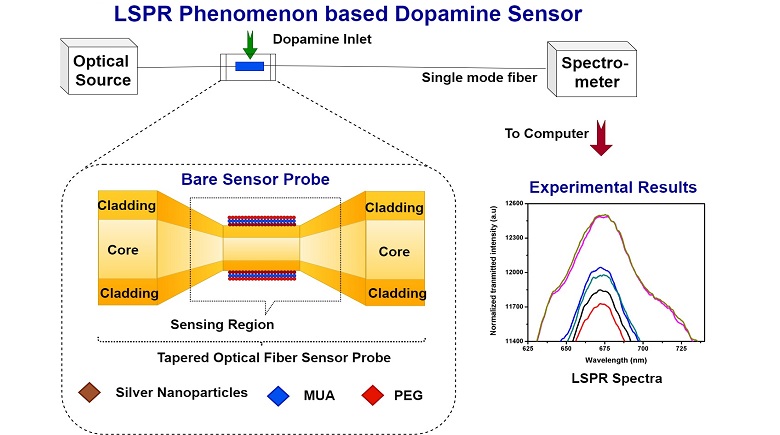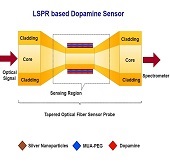
Biosensing and medical diagnostics are one of the best-suited application areas for utilizing the optical effect of localized surface plasmon resonance (LSPR), used for the detection of dopamine in this study. Dopamine functions as a hormone and a neurotransmitter in the human body and plays a crucial role in the peripheral system. The LSPR technique has several advantages such as real-time, label-free detection and moderate technical requirements. The proposed sensors are immobilized with a small size of silver nanoparticles (AgNPs) of size 7.5 ± 0.5 nm followed by functionalized with 11-mercaptoundecanoic acid (MUA) and polyethylene glycol (PEG). The use of biocompatible AgNPs with multiple surface functionalities ensures a wide detectable range. The size, shape and composition of AgNPs were determined using high resolution- transmission electron microscope (HR-TEM) and energy-dispersive X-ray spectroscopy (EDS). The characterization of AgNPs-immobilized sensing probe was investigated using a scanning electron microscope (SEM). Functional test of proposed sensor over an ultra-wide-range of dopamine concentration (10 nM- 100 μM) which covers the range of dopamine concentration in central nervous system (10 nM- 1 μM), revealing great performance is executed. It shows the great selectivity towards detection of dopamine in the presence of other higher concentrated coexist biomolecules such as ascorbic acid. The peak resonance wavelength shifts linearity with an increasing refractive index of the solution, as expected theoretically. A noticeable improvement is recorded in the all-important sensing parameters (sensitivity, linearity, limit of detection, and correlation coefficient) of proposed sensors. The superior performance of the proposed sensor over the other testing parameters such as selectivity, reusability, and reproducibility makes it a strong contender for real-time medical diagnosis in dopamine detection. The proposed sensor can be used practically for in-vivo applications in future.

